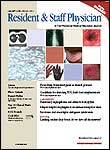Publication
Article
A 20-Year History of Recurrent Epistaxis
Prepared by Adam J. Rosh, MD, MS, Emergency Medicine Resident, Department of Emergency Medicine,New York University/Bellevue Hospital Center, New York City
A 65-year-old woman with a 20-year history of recurrent epistaxes presented to the emergency department for her third episode of epistaxis in a month. Her mother also had a history of epistaxis. Physical examination showed telangiectasias on her fingers (Figure 1), lips, and tongue (Figure 2).
Figure 1?Telangiectasias of the fingers.
Figure 2?Telangiectasias of the lips and tongue.
Points to remember: Osler-Weber-Rendu syndrome, also known as hereditary hemorrhagic telangiectasia, is an autosomal dominant disorder generally characterized by the triad of telangiectases, recurrent epistaxis, and a family history of the disorder. The major cause of morbidity and mortality is hemorrhage from these multiorgan arteriovenous malformations. Recurrent epistaxis is seen in up to 90% of patients. The most common physical findings are telangiectases of the skin, oral mucosa, nasal mucosa, and conjunctiva. Treatment is aimed at limiting the amount of hemorrhage and minimizing the sequela of chronic blood loss.
Diagnosis: Osler-Weber-Rendu syndrome.
